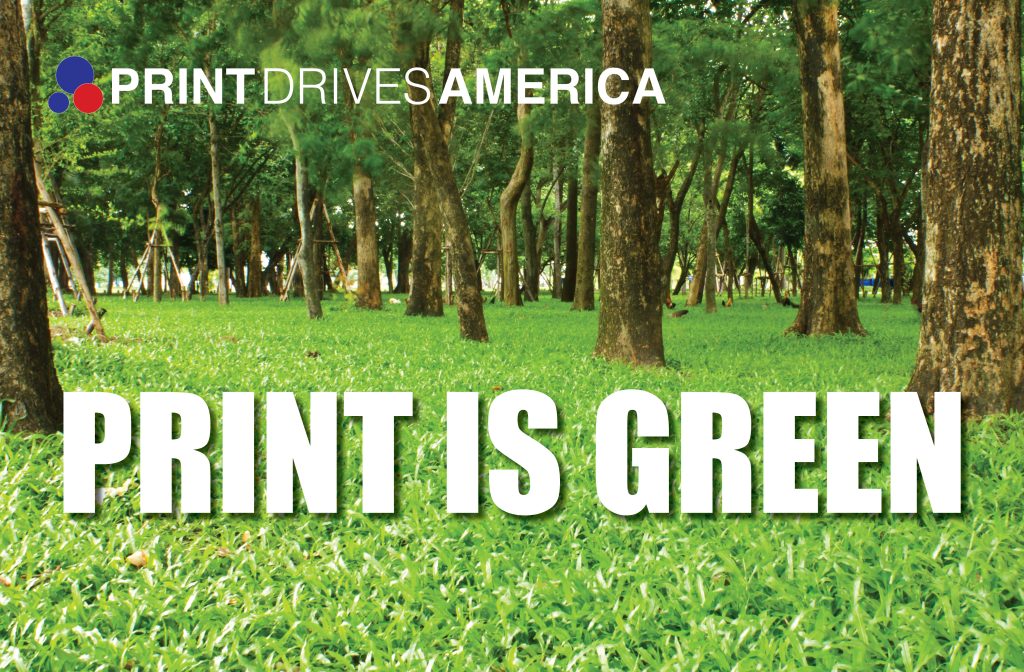
How eco-friendly is print? The answer might surprise you. When you think about the most environmentally friendly industries in the world, the print industry is probably not the first one that pops into your mind. The assumption is since we use paper, we must not be very green, right? Yet, the printing industry takes its responsibility to the environment very seriously.
Print is greener than you may think
There are a few significant drivers that make print a solid, eco-friendly choice. We’ve compiled some of the main truths that illustrate print’s green-ness and debunk the misperceptions:
- Paper is recyclable
Paper is the most recycled product in North America. The use of recycled paper reduces greenhouse gas emissions, carbon emissions and the overall energy needed for print production. Paper manufacturers can use the same recycled material up to seven times before it becomes unusable. - Paper is renewable
In the US, nearly 40% of paper comes from recycled materials. The remaining 60% must come from sustainable sources including managed forests and lumber byproducts. - Print marketing has a smaller carbon footprint than digital marketing
Carbon emissions are only produced once in the printing process during the momentary application of ink to paper, compared to online where energy is used 24/7 to transmit data among millions of devices (which too swiftly become permanent landfill). Reading on a screen requires a power source, and each time a digital device is used, more carbon emissions are created. - Digital media is NOT greener than print materials
Each year, millions of metric tons of e-waste are generated on our planet. The energy used to send emails also produces billions of metric tons of CO2 per year – about the same as a million cars. - Print production is good for trees
The print industry plants four times as many trees than they harvest each year. Almost all of the trees used come from responsibly managed forests, and those folks are replanting more than 4 million trees per day. We now have 20% more trees in the U.S. than we did 50 years ago.
Green methods of print
The print industry has been on the forefront of creating new and sustainable processes for years. Printers have adopted many of the following important green practices in order to streamline production and reduce the impact on the environment:
- Responsible paper sourcing
Making sure that paper and other raw materials come from environmentally sound sources. - Exercising eco-friendly paper practices
Recycled printing paper is both more accessible and more affordable than ever before and some eco-friendly papers today are made by paper companies that offset the carbon impact of producing the paper, making it carbon neutral. - Considering other power sources for sourced paper
Other types of eco-friendly paper are produced using renewable energy, such as wind power. - Sourcing tree-free paper
A unique and green printing technique includes using tree-free paper. These paper alternatives are derived from vegetable products such as bamboo, jute, wheat, straw or agricultural waste. - Noting the percentage of post-consumer waste in their recycled paper
Currently, there are more options available than ever before, including paper which is made with 100% post-consumer waste. - Eliminating wasteful production practices
Using print-on-demand services in place of bulk printing and storage dramatically reduces waste, lowers the client’s cost of obsolete materials and eliminates backorders. - Using soy and vegetable-based inks
Turning away from traditional, petroleum-based ink is one of the best moves a printing company can make toward going green. Petroleum-based inks are made out of non-renewable oil and release VOCs which have a number of negative environmental impacts. Vegetable-based inks are more sustainable and release no VOCs. - Practicing overall energy efficiency
Operating with the most energy-efficient machines, appliances, heating and air conditioning systems, and using CFL and LED light bulbs are ways to achieve considerable long-term energy-conserving results.
These and other sustainable printing processes increase a responsible printing company’s commitment to the environment by bringing green solutions to a market where assumptions are far too common. In actuality, many of the negative perceptions people have about the sustainability of print are false and industry advocates are launching campaigns to set the record straight.
Promoting the positive of print
Last month, the Printing Industries Alliance (PIA) foundation, Print Drives America, placed an ad in the national print edition of the Wall Street Journal, headlined “PRINT IS GREEN.” It is one of four in a series of advertisements meant to dispel myths about print and encourage its use. What They Think endorsed and publicized Print Drives America’s press release “One Million Wall Street Journal Business Readers See Page Three Ad That Emphasizes the Positive Use of Print,” which covered the WSJ article, furthering their exposure.
Print Drives America is the foremost advocate that the national print industry has in their corner, and they have enthusiastically become the voice of the industry. They give the print industry a stronger voice to demonstrate its amazing ROI and communicate its many benefits, including the strong consumer preference for print. Additionally, PIA and their foundation champion print by offering InDesign file templates and pdfs of the four-part, print-promoting campaign for companies and other organizations to download and edit. Participating businesses can easily add their company logo to create posters, send direct mail or place print ads.
We’re here for you
Navitor has a range of products and services that use the green printing methods referred to above. We have long been committed to improving our processes and helping our distributor partners and their customers choose options that reduce environmental impacts.